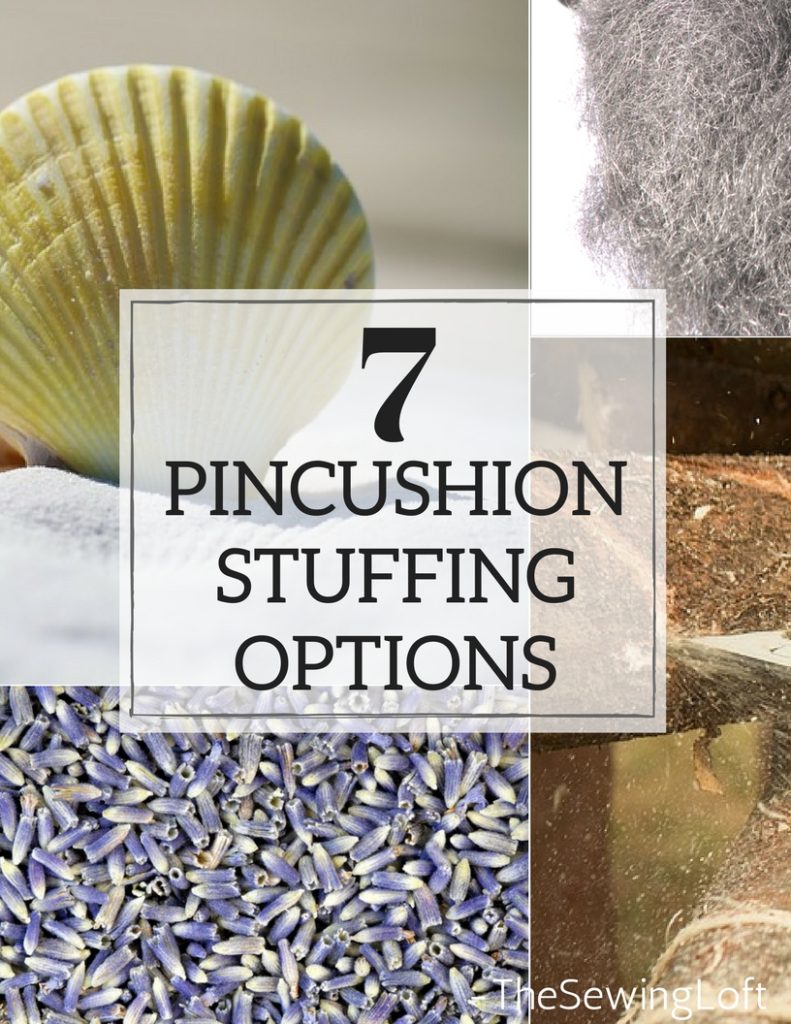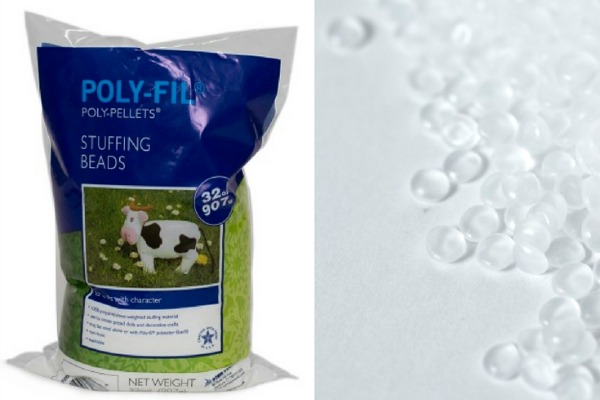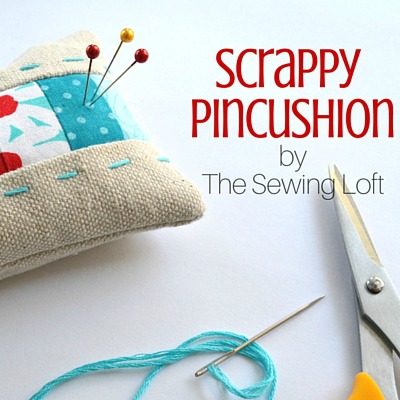What’s your favorite way to store pins while sewing? Pincushion, magnetic pin holder or strip, something else? Pins are one of those necessary sewing tools that we use on a regular bases, so many of us have a favorite method for storing them.
Today we’re talking about one of my favorites—the pincushion. They come in all shapes, sizes and colors and are a fun way to express your sewing creativity. When making one for yourself, one of the most important things for you to consider is the pincushion stuffing. You want it to be heavy enough to stay in place when using, so choosing the right filler is a must.
Here’s a list of some of the more popular ones, their pros and cons, and where you can find them.
Top Pincushion Stuffing Options
Sawdust
Pros: Sawdust is economical, readily available, and easy to use. It also has great compaction.
Con: Some wood is treated with oils and chemicals that can be harmful to children and small animals, so use caution when storing and using.
Buy: While your local big box home improvement store may not willingly hand over their leftovers (citing possible liability), your local wood shop or handy next door neighbor may be more generous.
Fabric Scraps
Pros: Economical and easy to find.
Cons: Can be a challenge to compact and not weighty. You’ll want to mix with something more substantial.
Buy: No need to buy. Just use your leftover fabric pieces from sewing.
Steel Wool
Pros: Great for sharpening pins and needles. They are small, so you’ll need to “stack” then with other steel wool or combine it with another stuffing.
Cons: Abrasive
Buy: Local hardware or Dollar stores or on-line here.
Quick Tip: Purchase the very fine grade. This will make it easier to work with and gently sharpen your pins each time you pull them out.
 Ground Walnut Shells
Ground Walnut Shells
Pro: Walnut Shells are economical and easy to find. They are also weighty and great for pin and needle sharpening.Offers great weight at and solid compaction inside your project.
Cons: Allergen
Buy: It’s carried in pet stores (usually in the reptile or bird section) as cage litter. It can also be purchased at your local quilt shop or on-line here.
Sand
Pros: Offers great weight and solid compaction inside your project.
Cons: In recent years there have been concerns about potential respiratory issues and toxicity.
Buy: Can be found in most home improvement stores, pet stores or here on-line.
Quick Tip: To avoid spilling, grab a funnel from the kitchen and pour over a covered surface for easy clean up.
Plastic Beads (Vase Filler)
Pros: Allergen free, good weight, easy to use and no airborne particulars (dust).
Cons: Not the best for sharpening your pins and needles.
Buy: Local craft supply store or here on line.
Lavender
Pros: Smells great (if you like lavender).
Cons: Not recommended as a “standalone” filler. It needs to be combined with another stuffing.
Buy: Fingers crossed you are lucky to have it blooming in your garden,. If not, you can buy in bulk here on-line.
Now that you know all the pincushion stuffing options, it’s time to look for that perfect pattern.
How did I do? Did I miss any of your favorite pincushion stuffing options? If so, be sure to leave me a note in the comment section so that it can be added to the list!
Hello! Are you new here?
Do you want to learn more about sewing? If so, be sure to sign up for our newsletter HERE and never miss a stitch! Daily Sewing Tips, Everyday Projects and Fantastic Inspiration delivered straight to your mailbox!
Bonus– free download with newsletter sign up.
Feel free to connect with me on Facebook, Pinterest, or Instagram. I look forward to getting to know you and stitching up a storm!




 Ground Walnut Shells
Ground Walnut Shells









Comments & Reviews
I use poly filling and white rice for weight in pincushions I make. Due to my allergies, I stay away from things that could cause a potential problem for me. A bag of white rice in pretty inexpensive and a 3 lb bag lasts me awhile. I stuff the bottoms of my pincushions full of rice to create a weighty base. Works great for me and I have given plenty away in online swaps. No one has expressed a problem with the white rice filling.
I have a few left over quilt blocks I want to convert to pin cushions for gifts…the rice is perfect…thank you for that suggestion.
Wondering with the comments about using hair, could I use dog hair when I comb my pooch?
I have never thought of that Sandy but I’m sure you could.
-Heather
I’ve used human hair. I think I made mine in the early 1980’s and I still use it!
I use knee-highs or pantyhose after they get runs in them, sometimes alone and sometimes with lavender or other scent-producers. They’re free and I have a semi-constant supply 🙂
I usually cut them in 4 to 6 inch strips just to make them easier to stuff.
Untreated sheep’s wool is also a good option, though again not very heavy. The lanolin in the wool helps prevent the pins going rusty. If you live near a sheep paddock it can often be found caught on fences.
Such a great idea Anne! Thanks so much for sharing.
~Heather
Hello, thank you for your ideas. I have also heard about emery or emery powder but have never found/used it. Any tips on that?
Be extra careful with Emery it’s toxic to humans and pets. Don’t breath dust wear a mask. But it will keep pins sharp.
Thanks so much for the tip Ardice. Safety is most important.
~Heather
My mother died at 85 and was originally from Japan. She taught me to stuff pin cushions with clean hair after a trim. It makes needles and pins glide more smoothly through fabric. Sometimes we would make an inner cushion to hold the hair to place inside the main casing. This is an old idea from the 1930s, but may be much older.
How wonderful that she passed down her love of sewing to you Amy. Thank you for sharing this interesting tip. I had never personally tried this before but have heard others chat about it. Maybe the next time I get a quick trim I’ll save it and give it a trip.
~Heather
I use buckwheat hulls and lavender. I grow my own lavender, so it’s readily available fresh or I leave it to air dry. Just roll it in your hands to refresh the smell. It smells so good! I find that rice will draw moths and if you get moths in your pantry, you have a mess. Cleaning well, throwing away many pantry foods, is the only way to get rid of them. ( this actually happened to me, right after a huge grocery purchase. I had to throw away a lot of food. A lot of waste so I just don’t bother with rice.
Rice used as stuffing can also attract mice. My mother made a neck wrap (heat in microwave then wrap around stiff joints). She stored it in a drawer, didn’t use it for months, and mice got to it. She lived on a farm, got mice regularly during fall and winter months.
As far as pantry moths and larvae, after dumping a huge amount of food from my pantry and battling with the life cycle of eggs, larvae and adult moths, I freeze all dried beans, peas, rice, oatmeal and cornmeal for a few weeks to kill any eggs that came in with the purchased products. Then I store them in airtight containers. Once you break the cycle and keep things stored properly, your foods will be safe.
ooh you grow your own lavender? would love to do that…suggestions please:) thanks
The very first thing we made on high school ” home ec ” (dating myself here) were wrist pin cushions. We stuffed them with hair.
You missed, washed raw sheep’s wool as a filler. Pros….. It can be compacted and the lanolin in it lubricates your pins and needles,so they slide thru fabrics easier.
Available from sheep breeders and online.
Never thought of that one Kellie. Thanks so much for sharing!
~Heather
Con: Animal fibers will attract wool moths if they are anywhere in the vicinity.
Lavender repels moths. I have put lavender dryer sheets in my bags of wool and alpaca fiber that are stored until I can get around to processing them and never had a problem. Seems like some lavender mixed in with the animal fiber would take care of that problem in a pincushion.
You forgot Emery sand which I believe is the best pincushion filler. It cleans and sharpens your pins and needles. It can be purchased from amazon and it was 11$ for a pound of sand.
I use dry rice. Weighty and asorbs moisture from the needles
I found this site with a google question. Does sand sharpen my needles…keep away the rust?
Kudos on the awesome, informative post! I love all the smart options you provided so much that I linked to this article on my blog for my readers as well. Thanks so much!
I find flaxseed to be a wonderful blend with lavender.
Does glad we’re go rancid after time?
Could you use mulling spices for stuffing a pincushion?
I’m sure you could but I wonder how long they would last for.
I use toy stuffing or left over bits of quilt batting cut up small.
Sometimes I add some lavender husks to the middle while stuffing.
If you pack the stuffing in tight it gives a very nice look to the finished pin cushion and adds some weight.
I bought (pet store) sand and may combine it with 0000 steel wool, but my question is willing any of these fillers *pop through* the fabric? Also wondered if anyone has made aida cloth pincushions?
I have my Grandmother’s pincushion that she made probably 70 years ago. The top is Aida cloth that she cross stitched and the bottom is plain fabric. It worked very well
I am converting an old velvet Christmasy pillow case that, I believe my grandmother had made, into a pincushion. It was in the form of a 9-patch quilt and needed mended anyway. I felt that I would never get around to using it as a Christmas pillow and since I needed a ‘just right’ pincushion, I thought I’d make one from that. Now I don’t have to feel guilty for not using something so special, and now I will actually see it MORE OFTEN! I’m excited! Now, to choose the filling! Thanks for the ideas!
I love the crushed walnut shells. Its heavy and keeps a pin cushion thread catcher combo in place. It’s very economically priced too. I also use it in.the bottom of my christmas Gnomes so they stay upright.
I use dried rosemary and pumice powder found at cosmetic suppliers. a little bag of pumice and rosemary on top. Smells so nice and sharpens needles.
Years ago I was given a pin cushion stuffed with salt. It still is going well.
That is great Reinette. Thank you for sharing.
-Heather